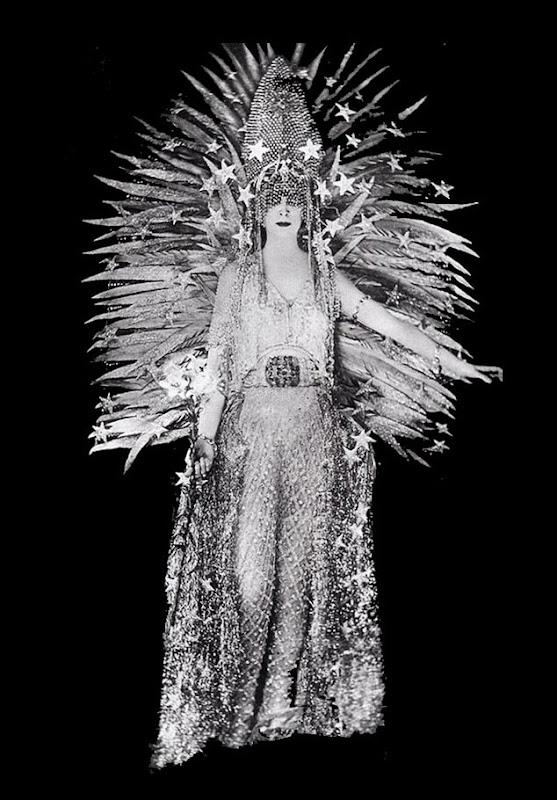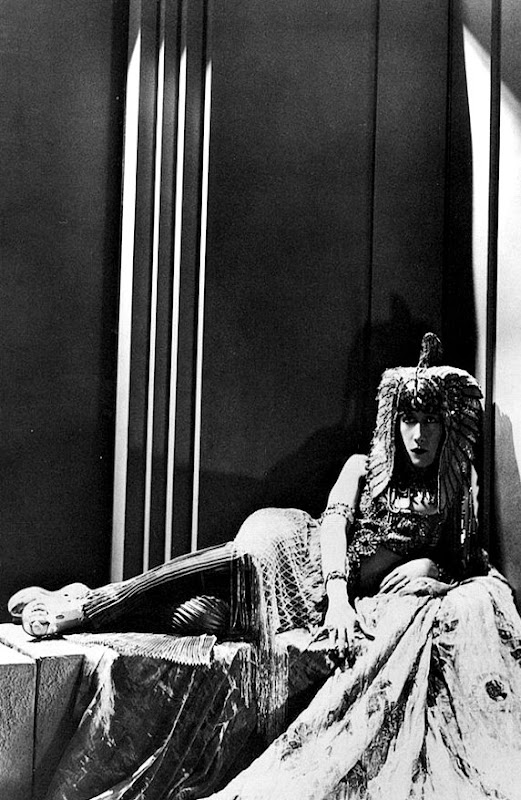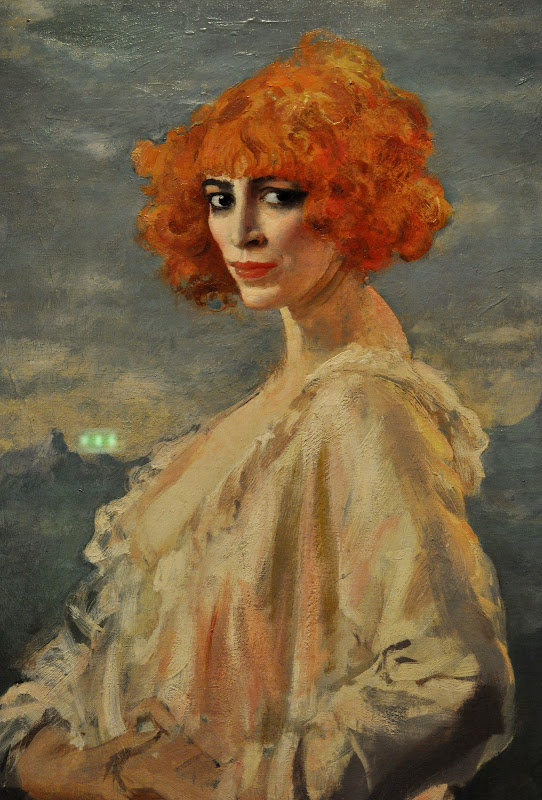



From the "Venetian Cat" blog:
The Divine Marchesa, Luisa Casati, proclaimed: "I want to be a living work of art!" and succeeded in her goal. Born in 1881 into one of the wealthiest families in Italy, she was electric, outrageous and eccentric, ahead of her time. For the first three decades of the 1900s, she was Europe's most astonishing celebrity, a muse and inspiration to some of the most important artists, fashion designers and thinkers of the era. Filippo Tommaso Marinetti, the founder of Futurism, called her, "The greatest Futurist in the world."
Luisa Amman was born in Milan on January 23, 1881 to an aristocratic family; her father, Count Alberto Amman was of Austrian descent and made his fortune in cotton; her mother, Lucia Bressi was Austrian and Italian; her older sister, Francesca, had been born almost exactly one year earlier on January 22, 1880. Early photos reveal a perfectly proper aristocratic family, spending their time doing perfectly proper aristocratic things. Then, on April 15, 1894, Luisa's mother died when Luisa was just 13 years old, and then, on July 11, 1896, her father died when she was 15 years old, making Luisa and Francesca the richest orphans in Italy - at impressionable ages.
In 1900, Luisa continued her proper aristocratic life by duly marrying Marchese Camillo Casati Stampa, and producing her only child, Cristina, the next year. Then, in 1903, Luisa met the flamboyant writer, poet and playwright, Gabriele D'Annunzio at a fox hunt; he was 18 years her senior and lover to Eleanora Duse. Luisa became his lover, and started her transformation into a living work of art.



Tilda Swinton as the Marchesa Casati
From The Telegraph:
In the late 1950s, when she was living in a one-bedroom flat near Harrods, the Marchesa Luisa Casati believed she was capable of communicating by telepathy. She stopped writing cards and letters, and spent her days indulging in spiritualist sessions with her few remaining friends. Cecil Beaton came to visit one afternoon and took a few ill-conceived snaps, where she appears blurred and cowering with her arm over her face, horrified she might be captured in her jowly, lace-veiled dotage.
Not long afterwards she died of a stroke. When he heard, a friend with whom she had conducted a séance earlier that morning let himself back into her flat to fetch her taxidermied Pekinese and a fresh pair of her false eyelashes. She was buried with both, in Brompton Cemetery, five days later. It was a miserable occasion, on an unseasonably cool, unsettled June day, and only a handful of family and friends attended. One of them came all the way from Venice, where half a century earlier he had been her personal gondolier, ferrying her jewel-collared cheetahs, her blue-painted greyhounds and her own decadently costumed form across the murky shimmer of the city’s lagoon.
Back then, Luisa Casati – heiress, socialite, artists’ muse – was a beacon of the belle époque, a legion of poets, artists, sculptors, designers and occultists trailing in her wake. She stuffed her palazzo on the Grand Canal (today the site of the Guggenheim Museum) with gold-painted servants, mechanical birds in gilded cages, a boa-constrictor and a pride of white peacocks that she tied to the windows, in the shade of her cypress trees. She once plundered their feathers for a costume, accessorising its white plumage with a dash of fresh chicken blood. Lady Gaga’s meat dress would have seemed quite dowdy.
The tendrils of Casati’s signature and often nonsensical style reach confidently into the present day. Georgina Chapman named her fashion label Marchesa after the Italian heiress, and over the years both Alexander McQueen and Tom Ford have cited her as inspiration for their collections, the latter christening Casati “the first European dandy of the early 20th century”.
At six feet and cadaverously skinny, Casati was not considered a beauty, but she made herself unforgettable all the same. Her hair was cut and dyed a fiery red, her skin bleached white with powder. She kept her pupils dark with doses of belladonna, and rimmed their lids in thick black Kohl, adding false eyelashes and strips of glued black velvet when the mood took her. It was not uncommon to see her prowling Venice with her cheetahs after dark, dressed in a cloak of silk velvet, mother-of-pearl heels and little else.
[By the time she lived in London, she had spent practically every penny of her fortune]...having never been a big eater, spent the pittance earned selling her remaining effects on gin and occult trappings. Ever the fashionista, she was sometimes seen rummaging through bins for scraps of fabric, dressed in threadbare clothes, a mangy fur hat and a scarf made of newspaper. “It took all of the dignity of the English,” wrote the French author Druon, who used her as the model for his 1954 novel La Volupté d’Etre, “not to just gawk at this phantom.”
For a woman who had devoted her life to making an exhibition of herself, perhaps, as her swansong, it wasn’t all that bad.
So incredible and so ingrained are these stories that it has become impossible to detach the myths and aspersions that have cobwebbed around her over the years. An exhibition devoted to her life – the very first – recently opened in Venice and its curators have spent years researching society columns of the time for the truth.

The exhibition The Divine Marchesa: Art and life of Luisa Casati from the Belle Époque to the spree years is on from 14th October 2014 to 8th March 2015 at the Palazzo Fortuny, Venice

Fascinating.
ReplyDeleteWe should be works of art too, all we are missing is the aristocratic blood and the money.
I can see us "rummaging through bins for scraps of fabric, dressed in threadbare clothes, a mangy fur hat and a scarf made of newspaper", however. Jx
Delete